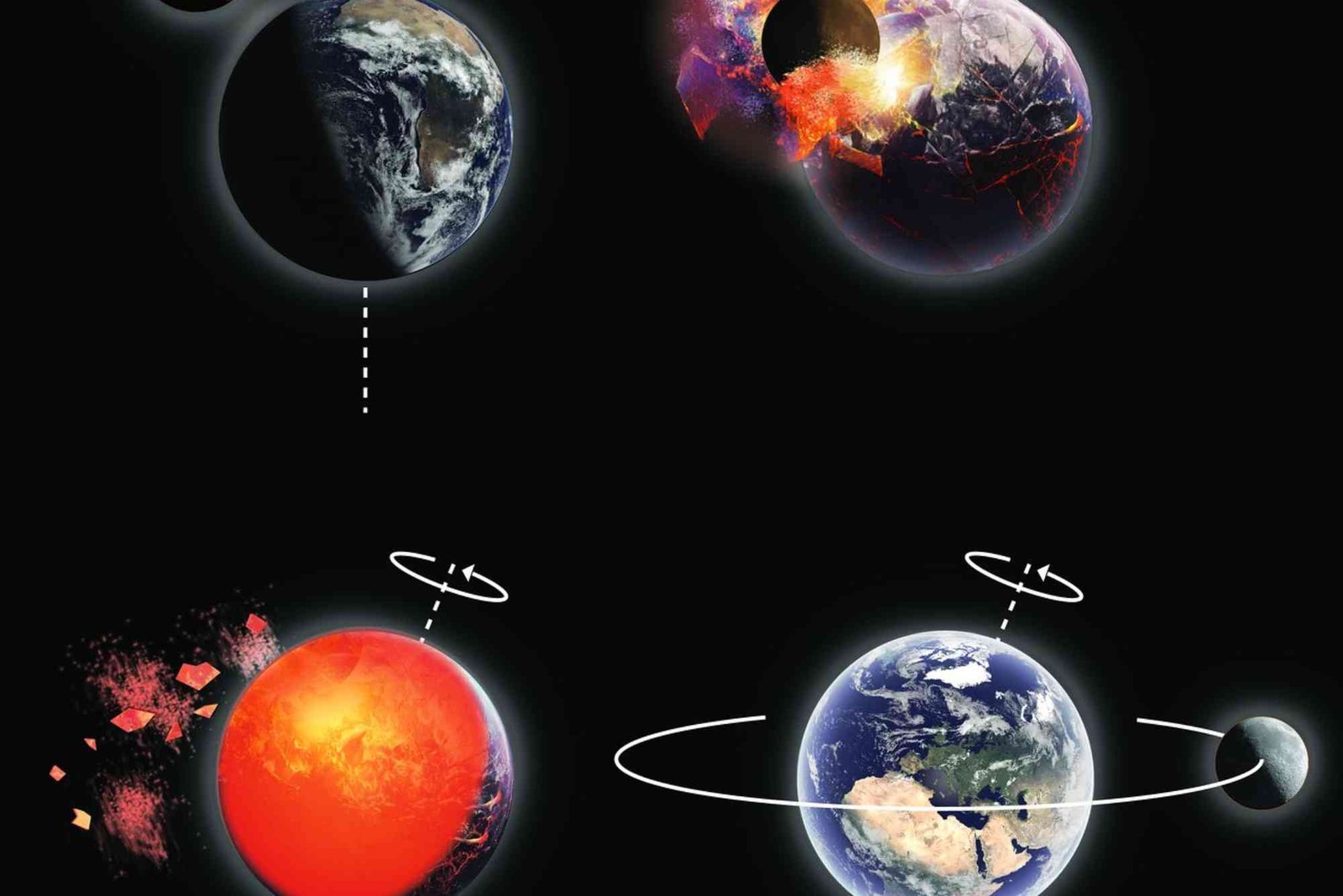Introduction
The Moon has always fascinated humanity — glowing softly in the night sky, guiding tides, and inspiring myths for thousands of years. But a question that continues to intrigue both scientists and curious minds is: How did the Moon form? This seemingly simple question opens a window into the violent and creative history of our solar system. Understanding the Moon’s origin not only helps us grasp Earth’s past but also reveals the processes that shaped other worlds.
The Beginning of a Celestial Mystery
When people first looked at the night sky, they created stories to explain the Moon’s presence. Ancient cultures believed it was a goddess, a chariot of light, or even a fragment of Earth’s soul. However, modern science paints a far more dramatic picture of its birth.
Billions of years ago, during the chaotic early days of the solar system, collisions between young planets and celestial bodies were common. Earth, still molten and forming, was struck by an object roughly the size of Mars. This event, known as the Giant Impact Hypothesis, remains the leading explanation for how the Moon came into existence.
The Giant Impact Hypothesis: The Most Accepted Theory
According to this theory, a Mars-sized planet called Theia collided with the early Earth about 4.5 billion years ago. The force of the impact was so immense that it ejected a massive amount of material into Earth’s orbit. Over time, this debris came together under the pull of gravity to form what we now see as the Moon.
Evidence Supporting the Giant Impact Theory
Scientists found several clues that strengthen this theory:
-
Similar Composition: The rocks collected from the Moon by Apollo astronauts have isotopic similarities to Earth’s mantle. This indicates that both bodies share a common origin.
-
Angular Momentum: The Earth-Moon system’s spin and orbit patterns can be explained by such a massive collision.
-
Computer Simulations: Modern models show that debris from such an impact could realistically form a stable moon within a few centuries.
A Violent but Creative Collision
While the event was catastrophic, it also stabilized Earth’s tilt, leading to regular seasons and predictable climates. Without the Moon’s gravitational influence, life on Earth might have developed very differently.
If you are curious about the broader question of the Moon’s cosmic journey, you can explore more about Where Did The Moon Come From — an insightful discussion on similar space mysteries.
Alternative Theories About the Moon’s Formation
Though the Giant Impact Hypothesis dominates scientific thought, other theories have been proposed throughout history. Let’s look at some of them and why they eventually lost favor.
The Fission Theory
This theory suggested that the Moon was once part of Earth and was flung away while the planet was still molten. Some scientists even proposed that the Pacific Ocean basin was the scar left behind. However, this idea was rejected because it couldn’t explain the Moon’s composition accurately or the physics of such an event.
The Capture Theory
Another theory stated that the Moon formed elsewhere in the solar system and was later captured by Earth’s gravity. While intriguing, this model doesn’t match the isotopic evidence showing that the Earth and Moon share the same materials.
The Co-formation Theory
According to this idea, Earth and the Moon formed together from the same dust and gas cloud. However, this theory also falls short, as it can’t explain the Moon’s smaller iron core compared to Earth’s.
These theories may not hold up today, but they show how human curiosity has pushed science to refine its understanding over time.
What the Moon’s Formation Tells Us About Earth
The Moon isn’t just a silent companion in the sky — it’s a record of Earth’s early history. Because the Moon lacks an atmosphere, its surface has remained relatively unchanged for billions of years. Studying lunar rocks allows scientists to reconstruct events from the dawn of our planet.
Stabilizing Earth’s Rotation
One of the Moon’s most critical roles is stabilizing Earth’s axial tilt. This stability keeps our climate moderate and seasons consistent, making it possible for complex life to thrive.
Controlling Ocean Tides
The Moon’s gravity pulls on Earth’s oceans, creating tides. These tides helped shape the evolution of coastal life forms and even influenced early biological cycles.
Reflecting Earth’s Ancient Past
Lunar samples brought back by the Apollo missions serve as time capsules. They contain evidence of the early solar system’s conditions and the massive impacts that shaped our world.
How Did Scientists Prove These Theories?
Astronomers and geologists combined multiple tools and disciplines to study the Moon’s origins. The evidence came from several sources, including space missions, simulations, and chemical analysis.
Apollo Missions and Moon Rocks
Between 1969 and 1972, NASA’s Apollo missions collected over 380 kilograms of lunar material. These rocks were compared to Earth’s crust and mantle, revealing a striking similarity. This confirmed that the Moon and Earth share the same origin material.
Advanced Simulations
With modern computing power, scientists can recreate conditions from billions of years ago. These simulations support the idea that a single colossal collision could create both the Moon’s mass and its orbit around Earth.
Isotopic Signatures
By studying oxygen isotopes in Moon rocks, scientists discovered they are identical to those found on Earth. This isotopic “fingerprint” was the decisive clue supporting the Giant Impact Hypothesis.
The Ongoing Mystery: Unanswered Questions
Despite this strong evidence, the story of the Moon’s birth isn’t completely closed. Some modern observations challenge the simple version of the Giant Impact Theory.
For example, new data from lunar missions show that the Moon’s composition might not be a perfect mix of Earth and Theia — it may have a unique chemical identity. This raises fascinating possibilities, such as multiple smaller impacts or more complex mixing processes.
Scientists are also investigating how quickly the Moon cooled after its formation and how its internal structure evolved. Future missions from NASA, ESA, and private organizations may finally uncover the missing pieces.
How Did the Moon Shape Human Civilization?
The Moon’s influence extends far beyond the physical. For ancient civilizations, it was a calendar, a light in the darkness, and a symbol of time and rebirth. Its cycles guided early agriculture, religious festivals, and navigation.
Even today, the Moon continues to inspire poets, scientists, and explorers. Modern lunar missions aim to build permanent bases and even use lunar resources to support human travel to Mars and beyond.
The Moon’s Future With Earth
The Moon is slowly drifting away from Earth at about 3.8 centimeters per year. This might seem small, but over millions of years, it will significantly change tides and the length of Earth’s days.
Eventually, this separation will alter our planet’s rhythm — but that process will take billions of years, giving humanity plenty of time to marvel at our cosmic companion.
For a deeper understanding of related topics and practical insights, check out our Related Blog article that explores how science and technology shape our modern world.
So, how did the Moon form? The most widely accepted answer remains the Giant Impact Hypothesis, where a young Earth collided with another planet-sized body. The result was not destruction, but creation — the formation of our Moon.
This celestial neighbor has influenced Earth’s climate, tides, and even the development of life itself. Yet, mysteries remain — and as we continue to study the Moon, we’re really learning about ourselves and our place in the universe.
To stay informed about the latest scientific discoveries, Learn more about the universe and ongoing space research shaping the future of human exploration.
(FAQ)
How did the Moon form in simple terms?
The Moon likely formed when a Mars-sized body collided with Earth about 4.5 billion years ago. The debris from this impact came together to form the Moon.
How old is the Moon?
Scientists estimate the Moon is about 4.5 billion years old — nearly as old as Earth itself.
Could the Moon have formed somewhere else?
Earlier theories suggested that the Moon might have formed elsewhere and was captured by Earth’s gravity, but evidence shows it originated from Earth’s material.
Why is the Moon important to Earth?
The Moon stabilizes Earth’s tilt, regulates tides, and helps maintain a steady climate — essential for life’s balance.
Is the Moon moving away from Earth?
Yes. The Moon drifts away from Earth at about 3.8 centimeters each year due to tidal forces.
What would happen if the Moon disappeared?
Without the Moon, tides would weaken, nights would be darker, and Earth’s tilt could become unstable — drastically changing our climate.












